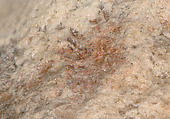On loan to The Met The Met accepts temporary loans of art both for short-term exhibitions and for long-term display in its galleries.
Marble female figure
Technical Analysis: Multiband imaging, optical microscopy, X-ray radiography, X-ray fluorescence spectroscopy, Raman spectroscopy
This large-scale, canonical female figure, carved of fine-grained white marble represents the Early Spedos type, characterized by broad flat proportions and some plasticity in rendering anatomical details. It has a plank-shaped profile with a slightly rounded silhouette. The oval head with a flat top sits upright on the neck, and a long triangular nose carved in high relief dominates the facial plane. Arched eyebrows and large almond-shaped eyes with circular pupils, represented in low relief, are preserved since they were originally covered with paint. Fainter paint-ghosts on the forehead indicate another pair of eyes. Traces of two wisps of hair are noticeable at the lower corners of the back of the neck. The ears are oval and rendered in relief. A deep groove delineates the rounded chin from the top of the broad neck. Another groove, curved in the front and v-shaped at the back, denotes the base of the neck.
The shoulders are broad and the chest is flat except for two teardrop-shaped breasts in low relief. The arms are slightly rounded, bent at the elbows, and stacked left over right. Short parallel incisions indicate fingers on each. A long horizontally incised line defines the top of the pubic triangle and two angled deep grooves delineate it from the top of each thigh. The bottom of the pubic triangle continues into a notch carved between the tops of the thigh which then becomes a deep vertical groove between the broad flat thighs. The better state of preservation of the surface of the marble indicates that this area was likely painted. From above the knees to the ankles the legs are separated. The disproportionately short calves are more plastically rendered than the upper legs and are carved back to indicate a slight bend at the convex knees. The ankles are connected and the feet arch downward and slightly outward. Short incisions indicate five toes on each foot. At the back the transitions from head to neck and from neck to torso are marked by incised lines and grooves. A deep vertical incision indicates the spine and the separation of the slightly thickened buttocks. The backs of the knees are concave indicating their bent position.
This large-scale female figure is one of the very few (and fifth largest) known marble figures measuring over 60 cm. high. Its broad flat shape and some more plastically rendered anatomical details are characteristic of the Spedos typHowever,ver the schematic rendering of the breasts recalls much earlier figures. This feature and other unique details, such as the unusually prominent paint-ghost facial features and hair, emphasize the need for further examination and analysis. Pat Getz-Gentle discusses these features and attributes this figure to the Karlsruhe-WoodnSculptor. (r.(1)
The front of the figure is worn and pitted with prominent erosion along calcite grain boundaries, and several arched parallel lines of pitting are visible on the right back side of the hair. Some painted and relief details are preserved due to preferential weathering. There is an additional smooth, almond-shaped area (possibly an eye?) surrounded by eroded marble on the right side of the torso. It does not appear to be related to a painted decoration. There are traces of red pigment identified as cinnabar, likely associated with iron oxides, along the right upper neckline and hairline on the back. In some places the red pigment appears to extend over the buff-colored accretion. There are traces of red pigment between the second and third toe of the right foot and a few particles of bright red pigment above the right eye near the edge of the “headdress” which are likely modern contaminations. Black tideline stains, rich in fine carbon-based particles, are visible in the pubic area. The back of the figure is less eroded than the front, except for extensive pitting on the neck. There is evidence that scattered buff-colored burial accretions have been reduced mechanically.
There are restored breaks across the neck, knees and between the ankles. Joins at the neck and knees were reinforced with internal metal pins affixed in drill holes. Mounting pins were cemented in holes drilled into the underside of the feet. A small restored loss along the break at the right part of the neck and a larger oval-shaped restoration on the back of the right upper arm and elbow show as darker areas in X-ray images, indicating the fill material is considerably less opaque than the stone. The bridge between the feet appears to be filled. Losses at the outer two toes on the left foot and the fourth toe on the right foot have been filled with a beige material that appears dark, or nonfluorescent, under Ultraviolet light. There are numerous spots of a similarly nonfluorescent restoration material on the front of the figure. The marble is worn and slightly soiled from handling with scattered scratches in areas, such as at the back of the head. Scrapes and traces of modern paint from a modern mount are visible between the legs on the back.
Georgios Gavalas, Dorothy Abramitis, Linda Borsch, Federico Carò
(1) See Getz-Preziosi, Pat. 1987. Early Cycladic Art in North American Collections (Exhibition catalogue, Virginia Museum of Fine Arts, Richmond), no. 39 pl. II, p. 178-179. See also Pat Getz-Gentle, Personal Styles in Early Cycladic Sculpture. (The University of Wisconsin Press, Madison, Wisconsin 2001 74-79, 158 no1, 177, pl. 64a, 65a, 66a.
#1337: Marble female figure
This image cannot be enlarged, viewed at full screen, or downloaded.
This artwork is meant to be viewed from right to left. Scroll left to view more.














